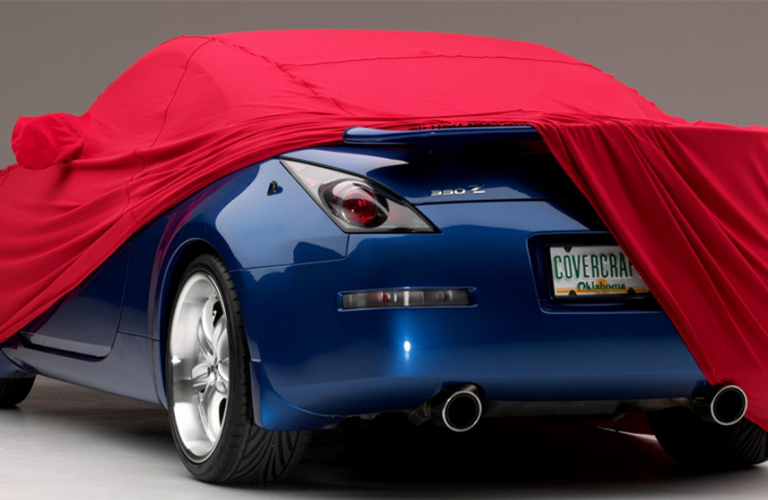About
Car covers are protective covers designed to shield a vehicle from various environmental factors such as rain, snow, sun, dust, and dirt. They are typically made of a waterproof or water-resistant material that is UV-resistant and breathable to prevent mold and mildew growth.
Car covers come in a variety of sizes and shapes to fit different types of vehicles, including cars, trucks, SUVs, and vans. Some covers are designed to fit specific models or makes of cars, while others are more generic and can fit multiple types of vehicles.
Car covers can be used both indoors and outdoors, and they provide a layer of protection against scratches, dents, and other types of damage that can occur when a vehicle is left exposed to the elements. They also help to keep a car clean and maintain its appearance.
Overall, car covers are a useful accessory for any car owner looking to protect their vehicle from environmental factors and preserve its condition.
Overview
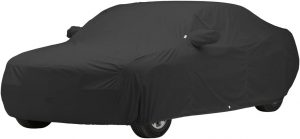
Car covers are protective accessories designed to protect vehicles from various environmental factors, including rain, snow, sun, dust, and dirt. They come in different sizes and shapes to fit different types of vehicles and are made of waterproof or water-resistant materials that are UV-resistant and breathable to prevent mold and mildew growth.
Car covers are used both indoors and outdoors and provide a layer of protection against scratches, dents, and other types of damage that can occur when a vehicle is left exposed to the elements. They also help to keep a car clean and maintain its appearance, which can extend its lifespan and improve its resale value.
Car covers are available in a range of materials, including polyester, nylon, and polypropylene, with different levels of thickness and durability. Some covers are designed to fit specific makes and models of cars, while others are more generic and can fit multiple types of vehicles.
Overall, car covers are a useful accessory for car owners looking to protect their vehicles from environmental factors and maintain their appearance and value over time.
Pros & cons
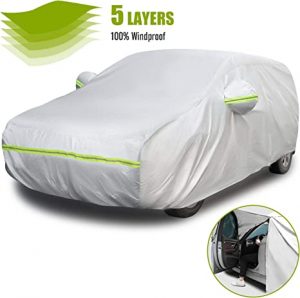
Pros:
- Protection: Car covers provide protection from environmental factors such as rain, snow, sun, dust, and dirt, which can cause damage to a vehicle over time.
- Maintenance: Car covers help to keep a vehicle clean and reduce the frequency of washing, which can save time and money in the long run.
- Durability: Car covers are made of durable materials that can withstand harsh weather conditions and protect the vehicle from scratches and dents.
- Convenience: Car covers are easy to use and can be easily removed and stored when not in use.
- Cost-effective: Car covers are relatively inexpensive compared to the cost of repairing or repainting a vehicle that has been damaged by the elements.
Cons:
- Fit: Car covers may not fit perfectly on every vehicle, which can lead to gaps and areas that are not fully protected.
- Time-consuming: Putting on and taking off a car cover can be time-consuming, which may be inconvenient for some car owners.
- Heat retention: In hot climates, car covers can trap heat and cause damage to the paint and interior of a vehicle.
- Wind damage: Car covers can be blown off in high winds, leaving a vehicle exposed to the elements.
- Maintenance: Car covers may require regular cleaning to prevent mold and mildew growth, which can be time-consuming and expensive.
The Pros and Cons of Indoor vs. Outdoor Car Covers
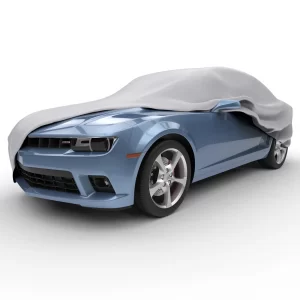
Indoor Car Cover Pros:
- Protection: Indoor car covers provide protection against dust, dirt, and other indoor pollutants that can damage a vehicle.
- Preservation: They help to preserve a vehicle’s paint and interior by preventing fading and cracking.
- Convenience: Indoor car covers are easy to put on and take off, making them a convenient way to protect a vehicle.
- Durability: Indoor car covers are made of durable materials that can withstand indoor conditions, such as low humidity and low sunlight exposure.
- Cost-effective: Indoor car covers are generally less expensive than outdoor car covers, making them a cost-effective option for car owners who want to protect their vehicle.
Indoor Car Cover Cons:
- Limited protection: Indoor car covers do not provide protection against outdoor elements such as rain, snow, and sunlight.
- Mold and mildew growth: If an indoor car cover is not breathable, it can trap moisture and lead to mold and mildew growth on a vehicle.
- Heat retention: Indoor car covers can trap heat and cause damage to the paint and interior of a vehicle.
Outdoor Car Cover Pros:
- Protection: Outdoor car covers provide protection against outdoor elements such as rain, snow, and sunlight.
- Durability: Outdoor car covers are made of durable materials that can withstand harsh outdoor conditions.
- Preservation: They help to preserve a vehicle’s paint and interior by preventing fading and cracking caused by UV rays.
- Convenience: Outdoor car covers are easy to put on and take off, making them a convenient way to protect a vehicle.
- Customizable: Outdoor car covers come in various shapes and sizes to fit different types of vehicles.
Outdoor Car Cover Cons:
- Limited breathability: Outdoor car covers may not be breathable, which can trap moisture and lead to mold and mildew growth on a vehicle.
- Cost: Outdoor car covers are generally more expensive than indoor car covers due to their added features and durability.
- Wind damage: Outdoor car covers can be blown off in high winds, leaving a vehicle exposed to the elements.
- Maintenance: Outdoor car covers may require regular cleaning to prevent mold and mildew growth, which can be time-consuming and expensive.
How to Properly Clean and Maintain Your Car Cover
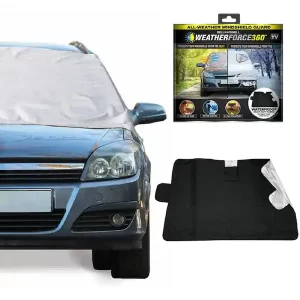
Proper cleaning and maintenance of a car cover can help to prolong its lifespan and ensure its effectiveness in protecting a vehicle. Here are some tips for cleaning and maintaining a car cover:
- Follow the manufacturer’s instructions: Read and follow the care instructions that come with the car cover to ensure that you are using the proper cleaning methods.
- Wash the cover regularly: Regular washing can help to prevent dirt, dust, and other debris from building up on the cover. Use a gentle detergent and cool water to hand-wash or machine-wash the cover.
- Avoid bleach and fabric softener: Bleach and fabric softener can damage the cover’s material and reduce its effectiveness in protecting the vehicle.
- Dry the cover properly: Allow the cover to air dry or use a low-heat setting in the dryer to avoid damaging the material.
- Store the cover properly: When not in use, store the car cover in a cool, dry place away from direct sunlight to prevent mold and mildew growth.
- Inspect the cover regularly: Regular inspections can help to identify any damage or wear and tear that may affect the cover’s effectiveness in protecting the vehicle.
By following these tips, car owners can ensure that their car cover remains clean and in good condition, providing maximum protection for their vehicle.
Car Covers for Classic and Vintage Cars:
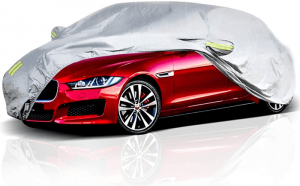
Car covers are an important investment for owners of classic and vintage cars, as these vehicles often require special care and protection to maintain their value and condition. Here are some factors to consider when selecting a car cover for a classic or vintage car:
- Material: Look for a car cover made of a breathable material, such as cotton or polyester, that will allow air to circulate and prevent moisture buildup. Avoid covers made of vinyl or other non-breathable materials that can trap moisture and lead to mold and mildew growth.
- Custom fit: A custom-fit car cover is essential for ensuring maximum protection for a classic or vintage car. Look for a cover that is designed to fit the specific make and model of the vehicle.
- UV protection: Classic and vintage cars are often prone to fading and damage from UV rays. Look for a car cover that offers UV protection to prevent sun damage to the vehicle’s paint and interior.
- Weather resistance: Choose a car cover that is designed to withstand the specific weather conditions in your area. If the car is stored outdoors, look for a cover that is waterproof and can protect against rain and snow. If the car is stored indoors, a lighter weight cover may be sufficient.
- Soft lining: Look for a car cover with a soft, non-abrasive lining to prevent scratching and damage to the vehicle’s paint.
- Storage bag: A storage bag is a useful accessory for protecting the car cover when it is not in use and keeping it organized and easily accessible.
By considering these factors, owners of classic and vintage cars can select a car cover that provides the necessary protection and care for their valuable vehicles.
How to Choose the Best Car Cover for Your Vehicle
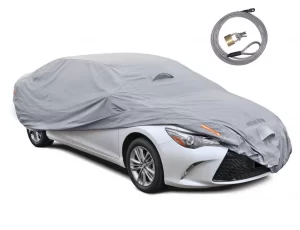
Choosing the best car cover for your vehicle can be a daunting task, but here are some key factors to consider when selecting a car cover:
- Type of cover: Decide on the type of car cover that you need. There are different types of covers available for different needs, such as indoor or outdoor, custom or universal fit, and full or partial coverage.
- Material: Look for a car cover made of a high-quality, breathable material that can protect your vehicle from environmental factors like UV rays, dust, dirt, and rain. Some common materials used for car covers are polyester, cotton, and nylon.
- Fit: The cover should fit your vehicle properly to provide maximum protection. Consider purchasing a custom-fit cover designed specifically for your vehicle’s make and model.
- Durability: The cover should be durable enough to withstand the elements and resist tears, punctures, and other damage.
- Ease of use: Look for a car cover that is easy to put on and take off, with features like elasticized hems, straps, and tie-downs.
- Price: Car covers vary in price, so consider your budget when selecting a cover. A more expensive cover may provide better protection and durability, but you can also find good quality covers at lower price points.
- Reviews: Check customer reviews to see what others have to say about the car cover you are considering. Look for reviews that specifically address your vehicle’s make and model to ensure that the cover will fit properly.
By considering these factors, you can choose the best car cover for your vehicle to provide the protection it needs and help maintain its condition and value.
FAQ

Here are some frequently asked questions about car covers:
What is a car cover?
A car cover is a protective covering that is designed to shield a vehicle from environmental factors such as dust, dirt, rain, sun, and snow. Car covers come in different materials and styles, and they can be used indoors or outdoors.
Do car covers fit all types of cars?
Car covers are available in various sizes and designs to fit different types of vehicles. It is important to choose a car cover that is specifically designed for your vehicle’s make and model to ensure a proper fit.
What are the benefits of using a car cover?
Using a car cover can help protect a vehicle from environmental factors that can cause damage, such as UV rays, dirt, and debris. It can also help to prevent scratches and dings from occurring, especially if the car is parked in a busy area.
Can car covers damage a car’s paint?
If a car cover is not properly installed or is made of abrasive materials, it can cause damage to a car’s paint. However, if a car cover is made of soft, non-abrasive materials and is properly installed and used, it should not cause any damage.
How do I clean a car cover?
The cleaning method for a car cover will depend on the material it is made of. Always refer to the manufacturer’s instructions for specific cleaning instructions. In general, car covers can be washed by hand or in a washing machine with a gentle detergent and cool water. Avoid using bleach or fabric softener, and allow the cover to air dry or use a low-heat setting in the dryer.
Are car covers waterproof?
Not all car covers are waterproof, but some are designed to be water-resistant or waterproof. It is important to choose a car cover that is suitable for the weather conditions in your area.
How long will a car cover last?
The lifespan of a car cover will depend on several factors, including the material it is made of, how often it is used, and how well it is maintained. With proper care and maintenance, a high-quality car cover can last for several years.
Conclusion
Car covers are an essential accessory for any car owner who wants to protect their vehicle from environmental factors like dust, dirt, rain, sun, and snow. They come in different materials, sizes, and styles, and can be used indoors or outdoors. Choosing the right car cover involves considering factors like the type of cover, material, fit, durability, ease of use, price, and reviews. When properly used and maintained, a car cover can help to maintain the condition and value of a vehicle for years to come.

